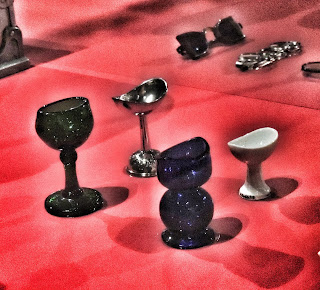 |
| Life-sized wax sculpture, 18th Century Said to resemble Queen Elizabeth I |
How would you feel about featuring this objet d'art on your mantelpiece or side-board? Reckon this two-faced figurine might put you off your Cornflakes?
Quite frankly, I'm unsure which side I find most scary: the fair or the foul. I suspect the witches from Polanski's Macbeth may be the only ones to covet a great many of the collectibles Sir Henry fancied.
 |
| Oil painting, c.1800 |
Vanitas or memento mori, that's what the genres into which these artworks fall are called. Queenie up above even has the relevant Biblical verse inscribed in Latin under her chin:
Vanitas vanitatum omnia vanitas
'Vanity of vanities, all is vanity.'
And the chirpy expression memento mori translates to 'Remember you will die'.
So the purpose of these beauties was to remind you that life is fleeting and vanity is futile. In fact, pretty much everything is futile, because we're all going to end up as worm food anyway.
Thanks for that.
 |
| I thought this was a woman but apparently it could be a young man in 17th Century finery. Even more than the snakes heading for his eye socket, I particularly like the frog on his shoulder. |
I like to imagine someone dressed in their finest frippery and furbelow (yes...it is really a word. And NO, it doesn't mean THAT...)
I like to imagine someone fabulous resplendently whipping it out like a compact as they head off to powder their nose.
Who needs a mirror?
During the month of April, I am participating in the Blogging from A–Z Challenge.
My posts will all feature images of and by the Wellcome Collection, Euston, London: the free destination for the incurably curious.



















